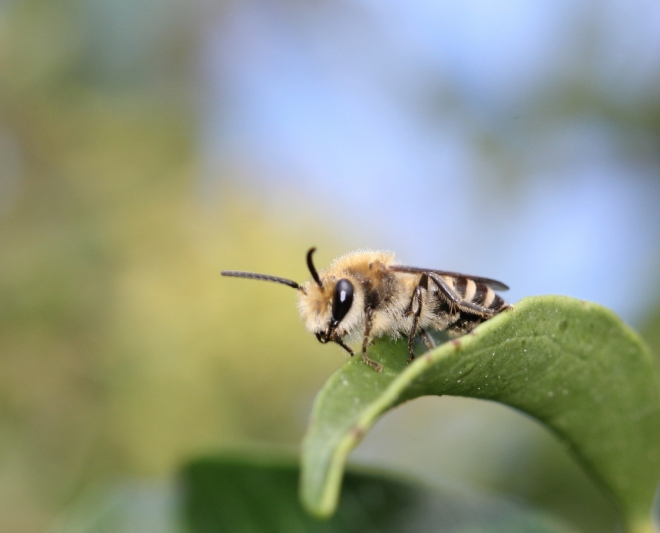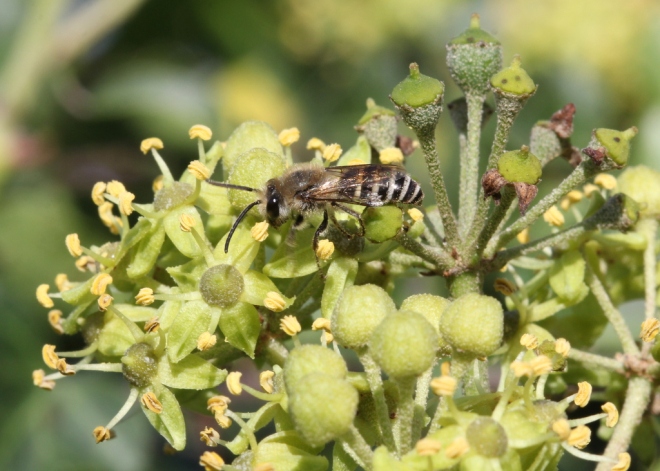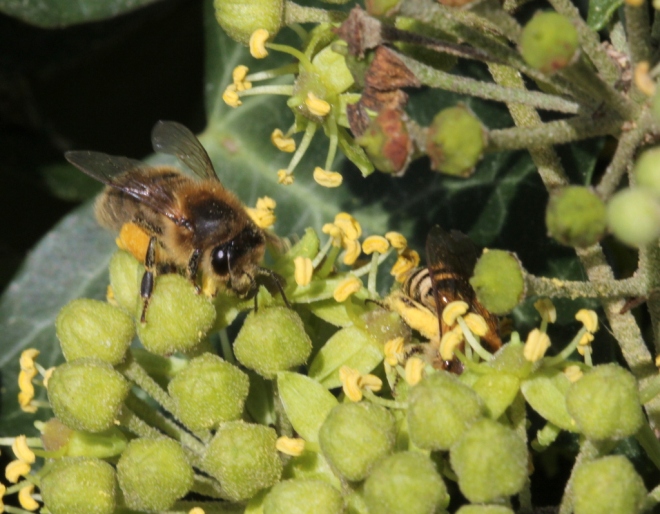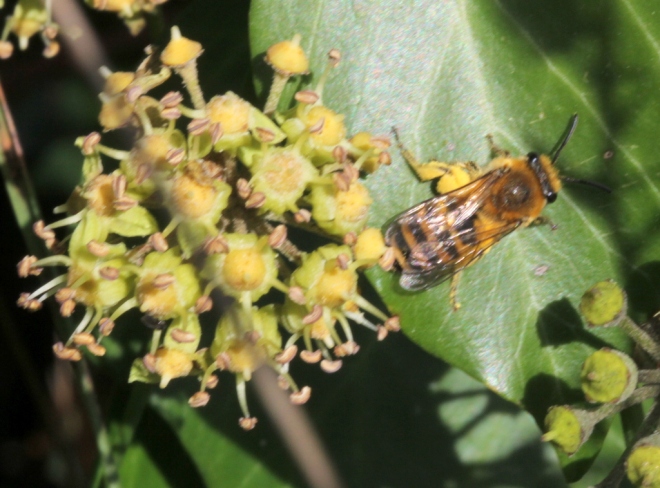My second post is on the last bee of the season that I have seen. I was so thrilled to find him that I used the photo above as the seasonal header for my garden blog a French Garden.
Colletes hederae is also called the Ivy Bee as until recently it was thought to be monolectic on ivy, that is it collected pollen only from ivy. Recents studies examining the pollen loads of C. hederae have shown that it will collect pollen from a variety of different sources.
The males of C. succinctus and C. halophilus are very similar to the male C. hederae so I do not think that either of them will be on the ivy near me. C. halophilus prefers coastal areas and both are more attracted to heathland. I have never found any heather growing nearby so it is not their preferred habitat.
The female is an eye catching bee and can be easily distinguished from the honey bees that are always present on the flowering ivy. She carries the pollen loosely all over her hind legs. In France they can be found between the end of August and the end of October. I took these photographs on a sunny day at the beginning of October.
I have a love hate relationship with ivy. In my garden it will choke all vegetation that stands in its way and for that reason I continually pull it out. Outside in the woods it grows high into the trees providing a wonderful source of nourishment for all kinds of creatures when it flowers at the end of the summer. Never the less it appears to me very invasive in the woods too, lying thick on the ground in many places choking out all competitors.
When the honey bees gather the ivy pollen their sacs have a much more waxy appearance.
Standing beside the ivy in full flower on a sunny day is a heady experience. The perfume from the flowers is intense. Different people describe the perfume as pleasant, of no particular interest or distinctly unpleasant according to their particular sensitivities.
Both the honey bees and the Ivy bees attempt to retrieve the maximum amount of pollen.
The honey bees too carry huge loads of the ivy pollen. It is difficult to imagine them flying back to their hives with such large loads.
Perhaps not all the pollen can be carried back without some being dropped but there is plenty for all.
My regret this year was that I was late in my search for the Ivy bee and I was not sure if the bee was present nearby. C. hederae nests in huge aggregates in the soil and the dry sandy soil of this area would provide an ideal base for nest building – the only problem is where. Now my challenge for next year will be to look out for suitable nesting sites for these late flying bees.









It’s great to see the ivy flowers providing food for the bees so late in the year. 🙂
LikeLike
It was amazing to see the number of different species of insects feasting on the ivy – not just the bees. There were some very pretty flies but I cannot face trying to identify the variety that was present.
LikeLike
I’m glad you’ve seen the Ivy Bee. Lots of new and exciting research about them at the moment as they colonise Britain. Regarding the waxy appearance of the pollen on the honey bee, you may already know this, but just in case not, the explanation is that they moisten it deliberately so it sticks better to their pollen baskets. It is one of the reasons they are not particularly good pollinators compared to many other species, especially the Megachilids, which carry dry pollen that attachs electrostatically to their pollen basket hairs and is therefore more vulnerable to being knocked off. With Apids little bits of pollen are not dislodged when they move to another flower.
LikeLike
I had never thought about the way the pollen was carried affecting pollination but now that you have explained it, it makes sense. I can imagine the Megachilids with their brushes being excellent pollinators.
LikeLike
I’m always slightly surprised how popular ivy is with bees, flies and wasps (maybe because I’m not an insect) – but is there such a thing as ‘Ivy Honey’?
LikeLike
I’ve talked to Michel about the different types of honey and he says it is very difficult to get a pure one flower honey. There has to be isolation. For instance, there are bee keepers who take hives onto the heather when it is flowering in Scotland and they will be able to collect pure heather honey. Michel gave me some honey he had made from lime tree flowers (Tilleuil), I had never tasted anything so good. However, seemingly it is very difficult to get one particular perfume in your honey, the bees can chose to go where they want. I would imagine that ivy honey is obtainable and certainly mixed flower honeys with a strong component of ivy nectar. Do you like the smell of ivy flowering?
LikeLike
I have tried a small piece of ivy honey – it’s bitter. Some people love it. Cecilia is right that it’s hard to get a pure mono-floral honey, but ivy is a little easier because relatively few other flowers are out at the same time in the autumn.
LikeLike
I had imagined ivy honey would have a distinctive flavour, how interesting to have actually tasted it. By the way it is Amelia, Emily, I should really sign my replies more but I forget 🙂
LikeLike
Sorry Amelia, I was thinking of Cecilia from http://thekitchensgarden.com – a wonderful blog full of animals, if you don’t already follow her.
LikeLike
Interesting. Thanks, both. In parts of Wales, along rivers where Himalayan Balsam has taken hold (e.g. Wye, Usk), there are hives from which (mostly) HB honey is produced. Seems pretty nice to me, but I’m not very discerning with honey. I just need a ladle. RH
LikeLike
It would be interesting to taste single flower honeys and see which ones we liked the best. I expect, as with all things, different people would have different preferences.
LikeLike
Gallivanta sent me here, what amazing photography and info you have!
LikeLike
Thank you. I was hoping that having a blog might allow me to meet some other solitary bee enthusiasts in France so we could exchange our information but I am fast coming to the realisation that watching solitary bees is not a popular pastime in France :(. Amelia
LikeLike
The French need converting! If I had time I’d sit around for hours just watching bees.
LikeLike
I think it will take more than me, Emily. We went to an excellent lecture on bats last week that had been arranged and was on the calender of a French nature association which covers all of Poitou-Charente. Two other couples attended. Amelia
LikeLike
Maybe you will lead the way, foster enthusiasm in others 🙂 Wendy
LikeLike
I would love to but I feel there is a distinct lack of interest. Amelia
LikeLiked by 1 person
Well, I may not be in France so not a connection in the way you hoped but apart from Bumble Bees which I love, I had never given any thought to “Solitary Bees” at all so there you go, you have enthused me 🙂
LikeLike
That’s great! All you need now is to make some bee hotels during the winter so you can see some solitary bees in the comfort of your own garden. You only need to tie some hollow stems together or, if you are handy with a drill, drill some holes in a branch or a lump of wood. Of course, you may already have mining bees in your garden. Then you would just have to look carefully for them going out and in their tunnels in the soil. 🙂 Amelia
LikeLike
🙂 I have my husband on to it, he has alot of recycled wood around so is going to build the frames and I can put them together. Such a lovely idea 🙂
LikeLiked by 1 person
I am carefully watching a large patch of ivy that is due to flower any day, I have great hopes for an Ivy Bee.
LikeLike
The ivy has just started to flower here but I hope to catch a patch on a sunny day too. Amelia
LikeLike